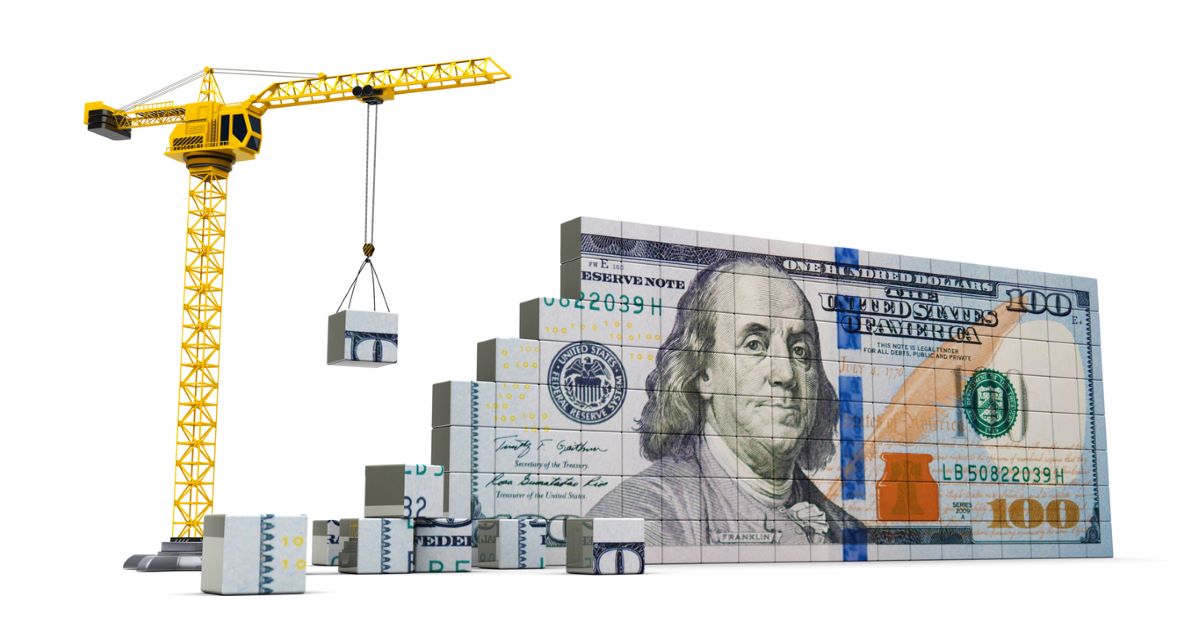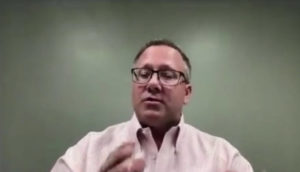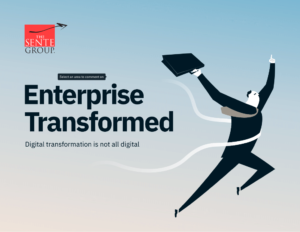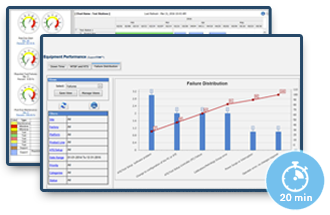

Industrial revolutions are triggered by the introduction of new tools. Companies that learn how to exploit these tools with a comprehensive capital structure strategy win. Those who do it first dominate. Companies that are engaged in “transformation” efforts must be focused on transforming the totality of their capital structures – not just their capital equipment – and have their complete set of capital structures aimed at enterprise goals and supporting enterprise strategies.
Traditional Thinking About Capital is Flawed and Incomplete
When most people think about capital, they think of capital equipment and the processes associated with it, all typically the purview of finance or capital managers. While these managers can plan for, acquire, and then measure and report metrics like return-on-assets, they cannot produce those returns without an intention to do so and a lot of directed help. Why? Because tools do nothing. They cannot produce returns by themselves.
We Need to Think about Capital Like an Economist
Economists define capital as anything businesses or individuals use to make money. ANYTHING. Not just capital equipment. To compete in today’s ultra-competitive marketplace, we all need to start thinking like economists. The first step is to distinguish categories of capital structures.
Categories of Capital Structures
When we distinguish categories of capital structures, we can begin thinking more strategically about how to produce the transformation of capital required to compete in today’s complex and ultra-competitive marketplace.
Human Capital is the value of the commitments people can make and fulfill. It is a result of their accumulated knowledge. It is this knowledge that produces returns on capital equipment. Human Capital is the first and most important category of capital.
Capital Equipment is any tool or artifact used to make money. Tools and artifacts amplify human capital.
Capital Inventory is the array of practices, narratives, and strategies companies use to make money. This also includes inventories of products or services ready to be sold.
Operating Capital is the cash required to operate the enterprise. When capital structures are coherently organized, they amplify each other, producing surpluses in cash.
Financial Capital is cash used to invest in a new enterprise or endeavor, often from surpluses.
The High Cost of An Incoherent Capital Structures Strategy
I was an executive in one of GE’s Technology Management Services businesses in the late 90s. Our business rented, remarketed, repaired, and calibrated test equipment. Their fundamental offer was a “capital structures” offer helping companies with their test equipment capital equipment concerns and capabilities.
The first set of conversations I had with customers was focused on cost. According to them, ours were “too high.” Their returns were too low.
I could not help but think the vast majority of the “asset” challenges they described to me, and the costs driving them had human capital gaps at their root. Their capital strategy, if they had one, had to be incoherent. Once we started filling the human capital gaps, we produced and used our capital equipment (computers) and capital inventory (software & practices) to help our customers produce amazing results.
- 50% reduction in asset acquisition and support costs
- 35% improvement in time to market
- Higher levels of employee accomplishment and job satisfaction
No amount of focus on capital equipment alone – how to maintain it, how to control it, or whether to rent, lease or own it would have produced anything close to these results.
Directing Capital Structure Transformation with Mission and Strategy
My intention when I founded Sente was to create a company that helped its customers leverage their driving capital scarcities, all of them, to succeed in their mission. This required we understand our customers’ mission, strategy, and capital structures and align ours to augment and enable theirs. Our help would need to be better than the incremental improvements to costs offered by common asset management solutions. We were also committed to developing ways to help them with time-to-market, something no other asset management solution provider could fathom.
This was made possible by our correct insight that the most significant asset management challenges were, at their root, human behavioral challenges much more than capital equipment challenges, although they were clearly related. To begin the process of capital structure transformation we first needed to understand those relationships.
The Key Insight: Human Capital Gaps Produce Capital Equipment (Asset) Management Gaps and they Produce Cost & Speed Gaps
We’ve written about these gaps extensively in other blog posts, like Asset Management Success Factors: It’s the Humans, Stupid! There is no need to go into much detail here other than to explain why human capital has been such a gap in the asset management space.
The first reason is that people don’t understand the relationships between categories of individual capital structures and the performance of the whole. There is more written on this below.
In addition, companies invest in capabilities that are core to their business. I’ve learned over the years that regardless of whether executives talk this way publicly, they act this way when making decisions. Whenever there was a trade-off between investing capital in a non-core function or on core capabilities it was the core that always won. Over time these non-core functions starved of investment lost their competitiveness and many were outsourced to companies for whom the investment in capital structures was core. Companies are always going to invest their scarce capital in what matters most to them…their products and services.
The customers we work with know that asset management is not now and will never be a core capability of theirs. They also find no one else in the industry has been able to produce the results we promise. This is so because no one else has had the insights we’ve had that make the outcomes we promise possible. Nor has anyone spent over 20 years building capital structures in support of these results. What exists broadly across the industry today is common asset management designed with old company missions and strategies in mind that won’t help transform capital structures to compete in today’s hyper-competitive, fast-changing marketplace.
The Transformation of Capital Structures for Asset Management that Supports Today’s Missions and Strategies.
Our capital structures would need to be aligned in support of our mission and consistent with our insights. As strategic partners, our capital structures need to fill our customer’s capital structure gaps.
Human Capital: We required people with skills that went beyond the technical knowledge needed to understand capital equipment. Our people needed to understand economic principles, incentives, culture, communications, and business concerns to design and execute solutions (capital inventory) that enabled our mission.
Capital Equipment: We required the latest tools and technology that our people exploit with their knowledge to develop and execute practices supporting our mission. Our tools need to amplify our human capital. This means investing in and exploiting the latest scanning technology, software development, knowledge management tools, infrastructure, and security.
Capital Inventory: Building capital inventory with marginal utilities that are highly valuable to our customers is the responsibility of every employee at Sente. We require employees who can contribute in this way, designing offers and practices that accomplished our mission of reducing our customers’ asset costs by over 50% while accelerating development schedules by 50%. Our teams developed utilization algorithms, total-cost-of-ownership models, governance practices, culture-change, capacity, and risk algorithms, and many more capabilities along with the strategies and explanatory narratives required to execute and produce the results we promise.
When we put our capital structures to work for our customers, we helped them significantly cut operating capital requirements and time-to-market. We’ve won many customer-best-practice awards and have been recognized by industry analysts for the significant help our software and services provided.
Financial Capital: Operating capital improvements for our customer (through reduced costs and improved margins) and us (margins from highly-valued services) have allowed both of us to continue to increase investment in our capital structures. In the case of one customer below, we helped them double their revenues.
Video Case Study
I was asked to present on Digital Transformation at the 38th Symposium of the International Test and Evaluation Association in the fall of 2021. In the video, Digital Transformation: Asset Management 5.0, I provide background to our solution, interviewed a customer about their challenges prior to working with us, discuss our approach to their challenges, and wrap up with an interview with the customer on the results we produced together.
- Cut asset base by 50%
- Reduced operating capital by 50%
- Accelerated Schedules 35%
- Reduced floor space requirements for equipment use and storage
- Doubled Revenue
- Increased employee satisfaction by helping them with “non-core” activities that enabled them to increase focus and skill on their core activities. Team members received rewards and recognition helpful to their careers
Our customer also mentioned that his company chose to work with us because his team “felt Sente was going to do something with us, not to us.” An indication of the kind of helpful human capital we are committed to building.

Helping our Customers Transform Their Core Capital Structures and Further Accelerating Products to Market
Today our unique approach to managing capital equipment enables us to help our customers transform all of their capital structures, not just capital equipment. For instance, we help them improve their human capital by establishing practical learning practices and action structures. Teams use our software to instrument and measure the performance of their various processes, establish cause and effect explanations for the outcomes produced, then plan, execute, and measure improvements. In addition to the “embodied” knowledge (human capital) the teams build through their engagement and analysis, they establish a knowledge base (capital inventory) designed to be practically useful and easily searchable for future teams to use. Practical Learning Practices applied to the test process, for instance, have resulted in improvements to cycle times of at least 50%.
Asset Management as Foundation for Transforming Capital Structures, Culture, and Performance
The ubiquitous use of a company’s capital equipment across all major enterprise processes combined with an understanding of how all capital structures relate to each other in the execution of a company’s strategy uniquely positions Scireo Accelerated Enterprise Asset Management as a vehicle for purposeful transformation of capital structures. Read more about this on Accelerate Transformation with Scireo aEAM: Asset Management 5.0 and enjoy the free ebook, Enterprise Transformed.

Request a Demo

See how Scireo aEAM Software drops asset and support costs by 50% while accelerating time-to-market 2X.
Relevant Content
Asset Management 5.0: Designed for Speed & Competitiveness
Accelerated Enterprise Asset Management (aEAM) is an award-winning software and services suite used by companies with complex, asset-intensive operations and demanding competitive requirements for better than incremental improvements to speed, agility, and cost-effectiveness. The same old solutions won’t work. This is where Scireo aEAM comes in oto help transform your business. The Results with Asset…
Asset Management 5.0: Software Training & Implementation Aimed at Outcomes
Unless you plan to produce great results, you don’t have a chance at producing them. They don’t happen by accident. The outcomes you aim at will specify what kinds of tools you will need and how you will need to use those tools. The same tools can be used by two different people or people…
Case Study: Aerospace Company Drives One Company Synergies
Like many aerospace companies, this one had many sites and different legacy cultures on each. See how they installed common resource management tools, increased utilization 3X and funded new programs.
Case Study: Semiconductor Company Increases Test Equipment Utilization
This company had a leading market share and wanted to solidify its position with its strategic customers by installing test capabilities on their sites. See how a 40% increase in bench utilization funded the project.
Notable Quotes
“What I love about Sente is how their approach and practices help turn our engineers into businesspeople.”
VP of Engineering, Fortune 50 Defense Contractor








